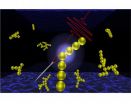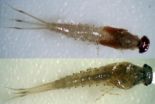(Press-News.org) A new method of building materials using light, developed by researchers at the University of Cambridge, could one day enable technologies that are often considered the realm of science fiction, such as invisibility cloaks and cloaking devices.
Although cloaked starships won't be a reality for quite some time, the technique which researchers have developed for constructing materials with building blocks a few billionths of a metre across can be used to control the way that light flies through them, and works on large chunks all at once. Details are published today (28 July) in the journal Nature Communications.
The key to any sort of 'invisibility' effect lies in the way light interacts with a material. When light hits a surface, it is either absorbed or reflected, which is what enables us to see objects. However, by engineering materials at the nanoscale, it is possible to produce 'metamaterials': materials which can control the way in which light interacts with them. Light reflected by a metamaterial is refracted in the 'wrong' way, potentially rendering objects invisible, or making them appear as something else.
Metamaterials have a wide range of potential applications, including sensing and improving military stealth technology. However, before cloaking devices can become reality on a larger scale, researchers must determine how to make the right materials at the nanoscale, and using light is now shown to be an enormous help in such nano-construction.
The technique developed by the Cambridge team involves using unfocused laser light as billions of needles, stitching gold nanoparticles together into long strings, directly in water for the first time. These strings can then be stacked into layers one on top of the other, similar to Lego bricks. The method makes it possible to produce materials in much higher quantities than can be made through current techniques.
In order to make the strings, the researchers first used barrel-shaped molecules called cucurbiturils (CBs). The CBs act like miniature spacers, enabling a very high degree of control over the spacing between the nanoparticles, locking them in place.
In order to connect them electrically, the researchers needed to build a bridge between the nanoparticles. Conventional welding techniques would not be effective, as they cause the particles to melt. "It's about finding a way to control that bridge between the nanoparticles," said Dr Ventsislav Valev of the University's Cavendish Laboratory, one of the authors of the paper. "Joining a few nanoparticles together is fine, but scaling that up is challenging."
The key to controlling the bridges lies in the cucurbiturils: the precise spacing between the nanoparticles allows much more control over the process. When the laser is focused on the strings of particles in their CB scaffolds, it produces plasmons: ripples of electrons at the surfaces of conducting metals. These skipping electrons concentrate the light energy on atoms at the surface and join them to form bridges between the nanoparticles. Using ultrafast lasers results in billions of these bridges forming in rapid succession, threading the nanoparticles into long strings, which can be monitored in real time.
"We have controlled the dimensions in a way that hasn't been possible before," said Dr Valev, who worked with researchers from the Department of Chemistry and the Department of Materials Science & Metallurgy on the project. "This level of control opens up a wide range of potential practical applications."
INFORMATION:
The paper, "Threading plasmonic nanoparticle strings with light" is published on 28 July in the journal Nature Communications. DOI: 10.1038/ncomms5568
Building 'invisible' materials with light
2014-07-28
ELSE PRESS RELEASES FROM THIS DATE:
Superconductivity could form at high temperatures in layered 2D crystals
2014-07-28
An elusive state of matter called superconductivity could be realized in stacks of sheetlike crystals just a few atoms thick, a trio of physicists has determined.
Superconductivity, the flow of electrical current without resistance, is usually found in materials chilled to the most frigid temperatures, which is impractical for most applications. It's been observed at higher temperatures–higher being about 100 kelvin or minus 280 degrees below zero Fahrenheit–in copper oxide materials called cuprate superconductors. But those materials are brittle and unsuitable for fabricating ...
Lifestyle choices may affect the long-term heart health of childhood cancer survivors
2014-07-28
A new study has found that following a healthy lifestyle may lower childhood cancer survivors' risk of developing the metabolic syndrome. Published early online in CANCER, a peer-reviewed journal of the American Cancer Society, the findings indicate that children with cancer and adults who had cancer when they were children should receive information about how their lifestyle may influence their long-term health.
Adults who had cancer as children are known to be at increased risk for the metabolic syndrome, a group of risk factors that increases the likelihood of developing ...
Nicotine found to inhibit DNA-strand break caused by a certain carcinogen in smoke
2014-07-28
A new in vitro study has revealed that nicotine and cotinine, a metabolite of nicotine, can potentially inhibit DNA damage caused by a certain carcinogen in smoke.
The carcinogen 4-(methylnitrosamino)-1-(3-pyridyl)-1-butanone or NNK is produced during the curing of tobacco leaves and ultimately ends up in the tobacco smoke. Once inhaled, it is metabolised in the lung and liver, where it is activated by a variety of enzymes called Cytochrome P450 (CYP). Previous research in mice has revealed that nicotine can partially interfere with the activation of NNK, and this has ...
Dinosaurs fell victim to perfect storm of events, study shows
2014-07-28
Dinosaurs might have survived the asteroid strike that wiped them out if it had taken place slightly earlier or later in history, scientists say.
A fresh study using up-to-date fossil records and improved analytical tools has helped palaeontologists to build a new narrative of the prehistoric creatures' demise, some 66 million years ago.
They found that in the few million years before a 10km-wide asteroid struck what is now Mexico, Earth was experiencing environmental upheaval. This included extensive volcanic activity, changing sea levels and varying temperatures. ...
Hepatitis C virus genotype 1 is most prevalent worldwide
2014-07-28
In one of the largest prevalence studies to date, researchers from the U.K. provide national, regional, and global genotype prevalence estimates for the hepatitis C virus (HCV). Findings published in Hepatology, a journal of the American Association for the Study of Liver Diseases, indicate that genotype 1 is the most prevalent worldwide, with over 83 million patients infected of which one-third reside in East Asia. Genotype 3, at just over 54 million cases, is the next most prevalent, followed by genotypes 2, 4, 6, and 5.
Despite efforts to control HCV, it remains one ...
New species of mayfly discovered in India
2014-07-28
Scientists have discovered a new species of mayfly in the southern Western Ghats, a mountain range along the west coast of India. In fact, this is the first time that any mayfly belonging to the genus Labiobaetis has been collected in peninsular India.
The new species, called Labiobaetis soldani, "is named in honor of Dr. T. Soldan for his substantial contribution to the understanding of the Ephemeroptera of Palaearctic and Oriental realms," according to the authors of a study that describes the new mayfly in the Journal of Insect Science.
The larvae have light-brown ...
Scientists discover new, noncommittal mechanism of drug resistance
2014-07-27
DURHAM, N.C. -- Microorganisms like bacteria and fungi can evade treatment by acquiring mutations in the genes targeted by antibiotics or antifungal drugs. These permanent mutations were once thought to be the only way for drug-resistant strains to evolve. Now a new study has shown that microorganisms can use a temporary silencing of drug targets -- known as epimutations -- to gain the benefits of drug resistance without the commitment.
Though the new mechanism was discovered in a fungus called Mucor circinelloides, it is likely to be employed by other fungi as well as ...
Study: Climate change and air pollution will combine to curb food supplies
2014-07-27
Many studies have shown the potential for global climate change to cut food supplies. But these studies have, for the most part, ignored the interactions between increasing temperature and air pollution — specifically ozone pollution, which is known to damage crops.
A new study involving researchers at MIT shows that these interactions can be quite significant, suggesting that policymakers need to take both warming and air pollution into account in addressing food security.
The study looked in detail at global production of four leading food crops — rice, wheat, corn, ...
Drugs used to treat lung disease work with the body clock
2014-07-27
Scientists from The University of Manchester have discovered why medication to treat asthma and pneumonia can become ineffective.
The findings, published in Nature Medicine, show that drugs widely used to treat lung diseases work with the body clock.
In the UK pneumonia, which is caused by an infection, affects around 1 in 1000 adults each year and is more serious for babies, young children, the elderly, smokers and those with an underlying health condition.
More than 5 million people in the UK are affected by asthma and the NHS spends around £1 billion a year ...
New drug target can break down cancer's barrier against treatment
2014-07-27
CANCER RESEARCH UK scientists at Barts Cancer Institute have found that targeting a molecule in blood vessels can make cancer therapy significantly more effective, according to research published in Nature today (Sunday).
The team at Barts Cancer Institute, part of Queen Mary University of London, have found that a molecule, called focal adhesion kinase (FAK), signals the body to repair itself after chemotherapy or radiotherapy, which kill cancer cells by damaging DNA. When the researchers removed FAK from blood vessels that grew in melanoma or lung cancer models, both ...



